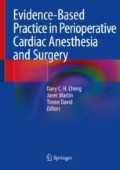Abstract
Adequate myocardial protection is an integral part of the safe conduct of cardiac surgery. The mainstay of myocardial protection is cardioplegia. Since the concept of reversible chemically-induced cardiac arrest was first introduced in the 1950s, a number of different cardioplegic solutions have been developed. As a result, there is wide variability in clinical practice and, despite the publication of numerous comparative clinical studies, there is no clear consensus regarding the optimal strategy for myocardial protection in adult cardiac surgery. In this chapter, we briefly survey the history of myocardial protection. We describe the main types of cardioplegic solutions currently available, and discuss controversies surrounding optimal temperature and method of delivery, highlighting the advantages and limitations of various approaches. Finally, we briefly discuss the emerging evidence regarding novel strategies for myocardial protection using single-dose solutions.
Access this chapter
Tax calculation will be finalised at checkout
Purchases are for personal use only
References
Ringer S. A further contribution regarding the influence of the different constituents of the blood on the contraction of the heart. J Physiol. 1883;4(1):29–42.
Bigelow WG, Lindsay WK, Greenwood WF. Hypothermia; its possible role in cardiac surgery: an investigation of factors governing survival in dogs at low body temperatures. Ann Surg. 1950;132(5):849–66.
Melrose DG, Dreyer B, Bentall HH, Baker JB. Elective cardiac arrest. Lancet. 1955;269(6879):21–2.
Tyers GF, Todd GJ, Niebauer IM, Manley NJ, Waldhausen JA. The mechanism of myocardial damage following potassium citrate (Melrose) cardioplegia. Surgery. 1975;78(1):45–53.
Cooley DA, Reul GJ, Wukasch DC. Ischemic contracture of the heart: “stone heart”. Am J Cardiol. 1972;29(4):575–7.
Reidemeister JC, Heberer G, Bretschneider HJ. Induced cardiac arrest by sodium and calcium depletion and application of procaine. Int Surg. 1967;47(6):535–40.
Hearse DJ, Stewart DA, Braimbridge MV. Cellular protection during myocardial ischemia: the development and characterization of a procedure for the induction of reversible ischemic arrest. Circulation. 1976;54(2):193–202.
Braimbridge MV, Chayen J, Bitensky L, Hearse DJ, Jynge P, Cankovic-Darracott S. Cold cardioplegia or continuous coronary perfusion? Report on preliminary clinical experience as assessed cytochemically. J Thorac Cardiovasc Surg. 1977;74(6):900–6.
Buckberg GD. A proposed “solution” to the cardioplegic controversy. J Thorac Cardiovasc Surg. 1979;77(6):803–15.
Guyton RA, Dorsey LM, Craver JM, Bone DK, Jones EL, Murphy DA, et al. Improved myocardial recovery after cardioplegic arrest with an oxygenated crystalloid solution. J Thorac Cardiovasc Surg. 1985;89(6):877–87.
Sellke FW, Shafique T, Johnson RG, Dai HB, Banitt PF, Schoen FJ, et al. Blood and albumin cardioplegia preserve endothelium-dependent microvascular responses. Ann Thorac Surg. 1993;55(4):977–85.
Hayashida N, Isomura T, Sato T, Maruyama H, Higashi T, Arinaga K, et al. Minimally diluted tepid blood cardioplegia. Ann Thorac Surg. 1998;65(3):615–21.
Guru V, Omura J, Alghamdi AA, Weisel R, Fremes SE. Is blood superior to crystalloid cardioplegia? A meta-analysis of randomized clinical trials. Circulation. 2006;114(1 Suppl):I331–8.
Teoh KH, Christakis GT, Weisel RD, Fremes SE, Mickle DA, Romaschin AD, et al. Accelerated myocardial metabolic recovery with terminal warm blood cardioplegia. J Thorac Cardiovasc Surg. 1986;91(6):888–95.
Yau TM, Ikonomidis JS, Weisel RD, Mickle DA, Ivanov J, Mohabeer MK, et al. Ventricular function after normothermic versus hypothermic cardioplegia. J Thorac Cardiovasc Surg. 1993;105(5):833–43. discussion 43–4
Lichtenstein SV, Naylor CD, Feindel CM, Sykora K, Abel JG, Slutsky AS, Warm Heart Investigators, et al. Intermittent warm blood cardioplegia. Circulation. 1995;92(9 Suppl):II341–6.
Martin TD, Craver JM, Gott JP, Weintraub WS, Ramsay J, Mora CT, et al. Prospective, randomized trial of retrograde warm blood cardioplegia: myocardial benefit and neurologic threat. Ann Thorac Surg. 1994;57(2):298–302. discussion−4
The Warm Heart Investigators. Randomised trial of normothermic versus hypothermic coronary bypass surgery. Lancet. 1994;343(8897):559–63.
Fremes SE, Tamariz MG, Abramov D, Christakis GT, Sever JY, Sykora K, et al. Late results of the warm heart trial: the influence of nonfatal cardiac events on late survival. Circulation. 2000;102(19 Suppl 3):III339–45.
Hayashida N, Ikonomidis JS, Weisel RD, Shirai T, Ivanov J, Carson SM, et al. The optimal cardioplegic temperature. Ann Thorac Surg. 1994;58(4):961–71.
Pratt FH. The nutrition of the heart through the vessels of Thebesius and the coronary veins. Am J Phys. 1898;1:86–103.
Lillehei CW, Dewall RA, Gott VL, Varco RL. The direct vision correction of calcific aortic stenosis by means of a pump-oxygenator and retrograde coronary sinus perfusion. Dis Chest. 1956;30(2):123–32.
Edelman JJ, Seco M, Dunne B, Matzelle SJ, Murphy M, Joshi P, et al. Custodiol for myocardial protection and preservation: a systematic review. Ann Cardiothorac Surg. 2013;2(6):717–28.
Mick SL, Robich MP, Houghtaling PL, Gillinov AM, Soltesz EG, Johnston DR, et al. del Nido versus Buckberg cardioplegia in adult isolated valve surgery. J Thorac Cardiovasc Surg. 2015;149(2):626–34. discussion 34–6
Matte GS, del Nido PJ. History and use of del Nido cardioplegia solution at Boston Children’s Hospital. J Extra Corpor Technol. 2012;44(3):98–103.
Author information
Authors and Affiliations
Corresponding author
Editor information
Editors and Affiliations
Rights and permissions
Copyright information
© 2021 Springer Nature Switzerland AG
About this chapter
Cite this chapter
Mazine, A., Lee, M.M., Yau, T.M. (2021). Myocardial Protection During Cardiac Surgery. In: Cheng, D.C., Martin, J., David, T. (eds) Evidence-Based Practice in Perioperative Cardiac Anesthesia and Surgery. Springer, Cham. https://doi.org/10.1007/978-3-030-47887-2_34
Download citation
DOI: https://doi.org/10.1007/978-3-030-47887-2_34
Published:
Publisher Name: Springer, Cham
Print ISBN: 978-3-030-47886-5
Online ISBN: 978-3-030-47887-2
eBook Packages: MedicineMedicine (R0)

